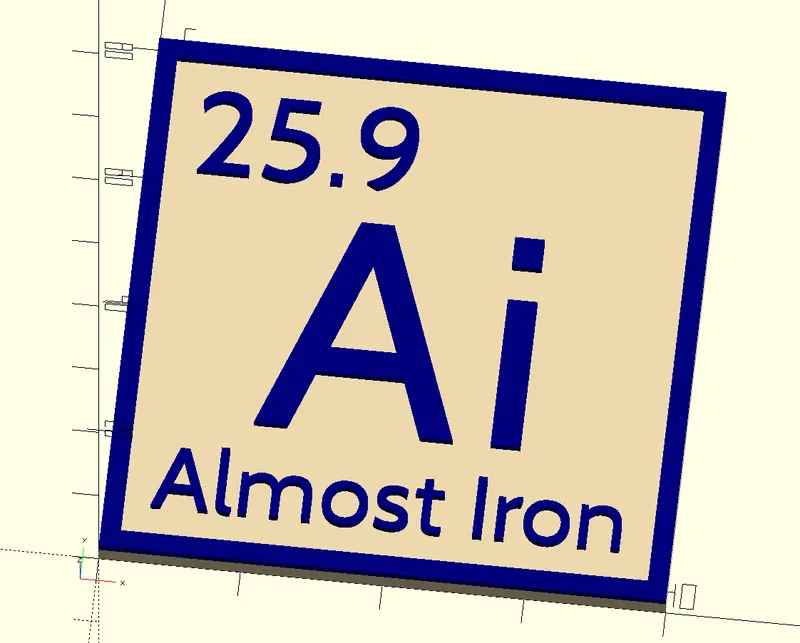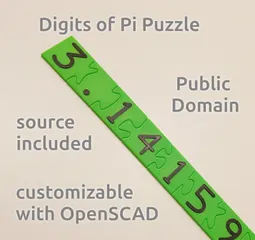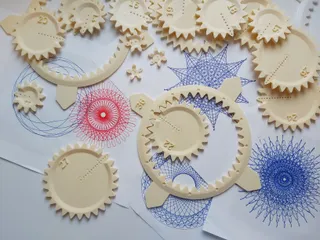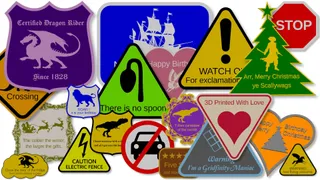Customizable Elements of the Periodic Table (OpenSCAD)
Description
PDFIntroduction
The base of this project is an OpenSCAD script that can be used to make single tiles or a text or a name of the Elements of the Periodic Table. The script has many options. All the 118 elements can be created with a batch file (a sh file for linux is included).
All the elements (and some extra) have already been created. The stl files are in a folder.
Tips for printing
The tiles are meant to be used with a filament swap.
For a good filament swap, I add a thin skirt of 2 lines around the model and I make the skirt as high as the layer where the filament is swapped. The skirt is printed first, and then there is no problem with filament that has leaked during the swap.
With a 0.4 mm nozzle, I found that a tile of 40 x 40 mm can still make readable text.
Most 3D printers have a bed of about 23 x 23 cm, and when the model is 45 degrees rotated, a model with 7 tiles is possible.
Without OpenSCAD
Without OpenSCAD, pick a pre-made stl file from a folder.
Type1
The style "Type1" is 45 x 45 mm, it is only 2.0 mm thick. If the layer height is 0.2 mm, then the top three layers could be printed with a other color via a filament swap.

With OpenSCAD
OpenSCAD has a "Customizer". It can be used to change the settings and to build a text from the elements. The settings can be stored (to a json file) to use the same settings the next time.
OpenSCAD is free software: https://openscad.org/
After installing it, download the script "Elements.scad". Open the script in OpenSCAD. There should be a "Customizer" on the right. If there is no Customizer, then check the menu to enable it.
There are many settings to try. If the result is okay, press F6 to render it and export it as a stl file.
In the Customizer, I named the parts as follows:

In the Customizer, a Fantasy Element can be created. For example:

SVG Output
The option to create a svg file can make a high resolution svg file for documents and for laser engraving. After rendering the model with F6, the result can be exported as a svg file.
The svg file can be adapted to adjust the fill and the stroke style. For example with Inkscape. Inkscape is a free vector design tool: https://inkscape.org/
The font that used here is "Bitstream Charter:Bold".

With OpenSCAD, the script and the batch file.
The script has a table with the elements. Extra fictional elements could be added to that table.
The batch file can create single tiles or texts with the elements. When multiple texts should be generated with a certain style, then the batch file makes that easy.
The batch file is a sh file for linux. It should be in the same folder as the script. Rename it from "make_elements.sh.txt" to "make_elements.sh". In a terminal, type "sh make_elements.sh" to generate the tiles.
The 2023 version of OpenSCAD is faster than the 2021 version. I suggest to use the newest and fastest version of OpenSCAD.
Other Element models and useful websites
A good website to create a text from the elements is: https://www.lmntology.com/
Those numbers can be used in my script. Fictional elements are used to make every text.
Wikipedia has good information about the elements and about fictional elements.
More fictional elements can be found at https://fandomium.fandom.com/
User @jfdor has a Periodic table magnet set with the OpenSCAD source script included.
User @ThomPatterson has a Fridge Magnets - Periodic Table of Elements with the Fusion360 source included.
License
The license is CC0 (Public Domain). You may create text with names and sell them. For someones birthday or the name of a city.
My goal is to contribute to the education of the elements of the Periodic Table, either in a serious or a funny way.
Tags
Model origin
The author marked this model as their own original creation.




